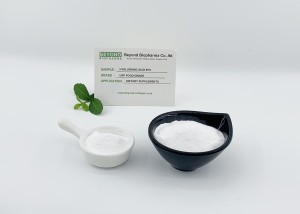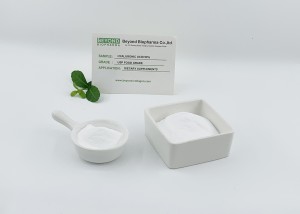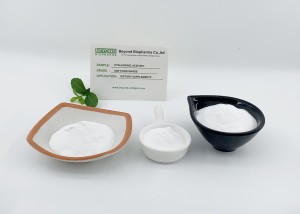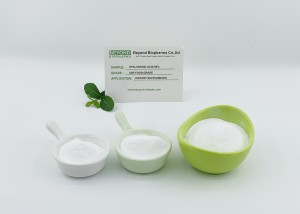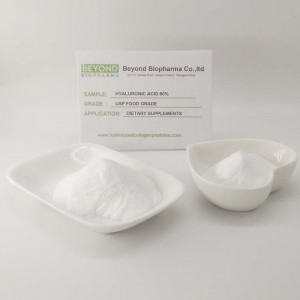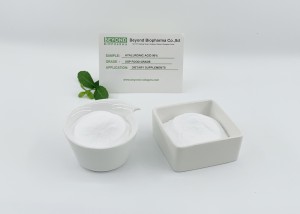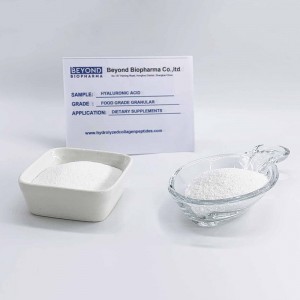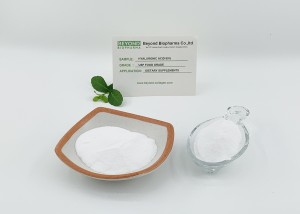USP Grade Hyaluronic Acid Powder is the Key Ingredients in Joint Healthcare Supplements
Hyaluronic acid is a glycosamine, a polysaccharide that is naturally found in the human skin, cartilage, nerves, bones, and eyes. Hyaluronic acid was extracted by fermentation. It is also an important component of the intra-articular fluid and is one of the components of the cartilage matrix.
Hyaluronic acid is the salt form of hyaluronic acid, which improves stability and reduces oxidation. The effect of hyaluronic acid on the joint is reduced, which can significantly improve the inflammation of liquid tissue, play the adhesion and lubrication function of joint fluid, protect the cartilage of joint cartilage, promote the healing and regeneration of joint cartilage, relieve pain, and increase the mobility of the joint.
| Material name | Food Grade of Hyaluronic Acid |
| Origin of material | Fermentation origin |
| Color and Appearance | White powder |
| Quality Standard | in house standard |
| Purity of the material | >95% |
| Moisture content | ≤10% (105°for 2hours) |
| Molecular weight | Around 1000 000 Dalton |
| Bulk density | >0.25g/ml as bulk density |
| Solubility | Water Soluble |
| Application | For skin and joint health |
| Shelf Life | 2 years from production date |
| Packing | Inner packing: Sealed Foil bag,1KG/Bag, 5KG/Bag |
| Outer packing: 10kg/Fiber drum, 27drums/pallet |
| Test Items | Specification | Test Results |
| Appearance | White Powder | White Powder |
| Glucuronic acid, % | ≥44.0 | 46.43 |
| Sodium Hyaluronate, % | ≥91.0% | 95.97% |
| Transparency (0.5% water Solution) | ≥99.0 | 100% |
| pH (0.5% water solution) | 6.8-8.0 | 6.69% |
| Limiting Viscosity, dl/g | Measured value | 16.69 |
| Molecular Weight, Da | Measured value | 0.96X106 |
| Loss on Drying, % | ≤10.0 | 7.81 |
| Residual on Ignition, % | ≤13% | 12.80 |
| Heavy Metal (as pb), ppm | ≤10 | <10 |
| Lead, mg/kg | <0.5 mg/kg | <0.5 mg/kg |
| Arsenic, mg/kg | <0.3 mg/kg | <0.3 mg/kg |
| Bacterial Count, cfu/g | <100 | Conform to the standard |
| Molds&Yeast, cfu/g | <100 | Conform to the standard |
| Staphylococcus aureus | Negative | Negative |
| Pseudomonas aeruginosa | Negative | Negative |
| Conclusion | Up to the standard | |
1. It helps to make things go smoothly. Hyaluronic acid helps your joints work like a good machine.
2. It prevents pain and damage caused by bones rubbing against each other.
3. It helps keep water. Hyaluronic acid is very good at holding water. A quarter teaspoon of hyaluronic acid contains about a one and a half gallon of water. This is why hyaluronic acid is often used in the treatment of dry eye disease. It is also used in moisturizers, lotions, oin, and essence.
4. It makes your skin elastic. Hyaluronic acid helps the skin stretch and bend, reducing skin wrinkles and fine lines.
5. Hyaluronacid has also been shown to help wounds heal faster and reduce scarring.
1. Help cartilage run properly: Hyaluronic acid helps lubricate joints and reduce friction between tissues. Improve the joint flexibility.
2. Keep the skin smooth: Hyaluronic acid, as a natural water lock factor, can promote the absorption of the skin or bone. This product will often be used in cosmetics, not only as edible skin care products, but also as a topical wet compress mask, or through medical beauty technology injection.
3. Keep your skin elastic: Hyaluronic acid helps your skin stretch and bend, reducing wrinkles and microgrooves. Mini-cosmetic surgery will be used as fillers.
4. Accelerate wound healing: Hyaluronic acid can improve the speed of wound healing and reduce scars.
1. Joint health field: Use it alone or in combination with collagen, vitamins, chondroitin sulfate, or glucosamine to treat joint-related problems. Joint hyaluronic acid is also used to treat osteoarthritis.
2. Skin care field: used as skin conditioner and viscosity agent in cosmetic formula, when applied to the skin surface, form viscoelastic membrane, inhibit the penetration of foreign substances and maintain skin moisture, can also be used for anti-aging skin preparations.
3. Medical field: for topical preparations for the treatment of skin irritation and acute and chronic wounds, such as abrasions and postoperative incisions, first and second degree burns, metabolic ulcers and pressure ulcers.
4. Ophthalmology: For ophthalmic surgery, including cataract extraction, corneal transplantation, retinal detachment, and other eye injuries. Because it is a natural component of the human eye, it is fully biocompatible.
Can I have small samples for testing purposes?
1. Free amount of samples: we can provide up to 50 gram of hyaluronic acid free samples for testing purpose. Please pay for the samples if you want more.
2. Freight cost: We usually send the samples via DHL/FEDEX. If you have DHL/FEDEX account, please let us know, we will send via your own account.
What are your ways of shipment?
We can ship both by air and be sea, we have necessary safety transportation documents for both air and sea shipment.
What is your standard packing ?
Our standarding packing is 1KG/Foil bag, and 10 foil bags put into one drum. Or we can do customized packing according to your requirements.

